Farnborough Hospital
Farnborough Common, Orpington, Kent, BR6 8ND
Medical
dates:
Medical
character:
Acute
The Bromley Union workhouse opened at Locks Bottom on 13th March 1845. The administration building, at the west of
the site, was connected to an accommodation
block at the rear by a central corridor. A third block lay
parallel to these two and more blocks were added later to the north
and
east.
By 1873 the workhouse could hold 420 inmates. In 1898 a female infirmary was built.
In 1907, the nursing staff consisted of a Superintendent Nurse and 8 nurses, a night lunatic attendant, a male imbecile attendant and a female imbecile attendant.
The workhouse had become severely overcrowded by 1910. The 694 inmates were mostly elderly, chronically or mentally ill, or children (at one time, of 426 inmates only 23 had been able-bodied). Two extra wards were built to accommodate the sick.
By 1923 two doctors were employed, while the nursing staff consisted of a Superintendent Nurse, an Assistant Superintendent Nurse, a Night Sister, 4 Ward Sisters, 2 Staff Nurses and 20 Probationers. In 1924 the infirmary had 201 beds. In 1925, it also had accommodation for 66 mental patients (although none occupied the padded cells).
By 1927 the workhouse and infirmary had become a hospital in all but name. Although it had no Out-Patients or Casualty Department, it was the only sizeable hospital between Lewisham and Tunbridge Wells. As the number of motor vehicles increased, so did the numbers of victims of road traffic accidents requiring treatment. The Ministry of Health asked the Board of Guardians to provide additional medical staff, but this was strenuously resisted on financial grounds.
The institution had no electricity and was lit by gas and portable paraffin lamps. The operating theatre, known as the 'greenhouse', was heated by a gas fire, which had to be extinguished before anaesthesia was given to the patient. Patients needing X-ray examination were referred to the Bromley Cottage Hospital, although occasionally a portable X-ray company was called in if a patient could not be moved.
In 1929 electricity was installed and two new medical blocks were completed. However, as Poor Law institutions were not allowed to refuse admission, the wards remained overcrowded, with beds in the centre of the rooms or even along the corridors.
In 1930, following the abolition of the Boards of Guardians of the Poor, management of the workhouse and infirmary was taken over by the Public Assistance Committee of Kent County Council. At this time the institution was considered to be the best Poor Law hospital in the county. It had 445 beds.
Plans were made to improve and develop the site. Lifts were installed, so that patients no longer had to be carried on stretchers up and down the stairs. The resident medical staff was increased to six. A new wing was completed in 1936, when the institution was renamed the Farnborough County Hospital. It had 811 beds.
In 1938 the weekly cost of an in-patient was £2 8s 4d (£2.42).
At the outbreak of WW2 in 1939, the Hospital joined the Emergency Medical Service (EMS) as the Farnborough Emergency Hospital under the control of Guy's Hospital. Marquees were erected to temporarily provide extra accommodation for anticipated air-raid casualties while 12 wooden hutted wards were being built where once had been gardens and orchards. The Hospital then had 1,200 beds. It received casualties from Dunkirk and also injured airmen during the Battle of Britain.
A Maternity Unit opened in 1940, with 16 antenatal beds (in one large ward) and 50 lying-in beds. The lying-in unit was on two floors and consisted of 12 single and 19 double rooms. There was a small block with 4 rooms for obstetric cases and a similar Isolation Block for suspect and septic patients. The latter was self-contained with its own Labour Ward and Sterilizing Unit. The babies were accommodated in two main general nurseries. There was also a Premature Baby Unit with 10 cots.
After the war, the 400 medical and nursing staff from Guy's Hospital returned to London, resulting in five wards having to be closed due to staff shortages.
In 1948 the Hospital joined the NHS under the control of the Orpington and Sevenoaks Group Hospital Management Committee, part of the South East Metropolitan Regional Health Authority. It was renamed Farnborough General Hospital and had 831 beds (not all of which were open because of staffing shortages).
By 1954 it had 657 staffed beds.
A new operating theatre suite was opened in November 1956 by R.H. Turton, the Minister of Health. It had cost £45,000.
The Hospital at this time had a nominal bed complement of 800, but the average occupancy was 650. The buildings - of many dates and styles - were detached and scattered over a considerable area. Some patients were accommodated in 2-storey brick buildings and some in the EMS hutted wards on either side of an enclosed corridor. The four largest hutted wards needed urgent replacement.
The Hospital had two kitchens - the main one in a brick building and the second one in an EMS hut, known as the Pavilion kitchen. Some 870 midday meals were made in the main kitchen, while the Pavilion kitchen prepared 330 meals (for patients, not staff).
The old workhouse isolation block was used by Central Stores, but it was in a isolated position and had been broken into on many occasions.
The Hospital employed three gardeners to look after the extensive grounds, but an outside contractor took care of the lawns, at a cost of £1,300 a year.
In 1961 some 45 beds had to be closed because of staff shortage, but these were spread over the Hospital, so that no ward closures were necessary. The operating theatre also had to close temporarily due to lack of trained theatre nurses.
In 1966, when the Hospital had 705 beds (60 of which were closed due to lack of staff), some 30-50% of junior grade doctors were from overseas. It had also proved difficult to recruit nursing, domestic and ancillary staff.
Nonetheless, a new Gynaecological Unit opened, consisting of two 14-bedded wards, each with a 2-bedded side ward and one private and one amenity bed.
A new Hall and Social Club were also built and the old Hall converted into a Nurses' Home, for those who had lived in Oakwood Hostel in the Hospital grounds. The Hostel in turn was then converted into accommodation for the resident medical staff.
In 1967, when the Hospital had 705 beds, it cost just over £850,000 a year to run. An extension to the Department of Psychiatry was opened by Lady Norman, C.B.E.
In June 1968 a new isolation ward with 17 beds was completed at a cost of £98,000 but could not be opened because of a shortage of trained nursing staff. (It remained unopened over a year later.)
In 1974, following a major reorganisation of the NHS, the Hospital came under the control of the Bromley District Health Authority, part of the South East Thames Regional Heath Authority.
In the early 1970s plans were made to upgrade the Hospital to a District General Hospital with 650 beds to serve its catchment area and also that of Orpington Hospital, which would then close.
In 1978 the Hospital had 603 beds, mainly for acute patients.
By 1980 there were 560 beds and, in 1985, 543.
In 1990 the bed complement was 520.
With the introduction of the 'marketplace' system of provider and supplier in the early 1990s, the Hospital came under the control of Bromley Hospitals NHS Trust. In 1995 it was decided to redevelop the site and build a new acute hospital under a Private Finance Initiative (PFI) scheme.
The old Hospital closed in 1998.
Present status (July 2008)
By 1873 the workhouse could hold 420 inmates. In 1898 a female infirmary was built.
In 1907, the nursing staff consisted of a Superintendent Nurse and 8 nurses, a night lunatic attendant, a male imbecile attendant and a female imbecile attendant.
The workhouse had become severely overcrowded by 1910. The 694 inmates were mostly elderly, chronically or mentally ill, or children (at one time, of 426 inmates only 23 had been able-bodied). Two extra wards were built to accommodate the sick.
By 1923 two doctors were employed, while the nursing staff consisted of a Superintendent Nurse, an Assistant Superintendent Nurse, a Night Sister, 4 Ward Sisters, 2 Staff Nurses and 20 Probationers. In 1924 the infirmary had 201 beds. In 1925, it also had accommodation for 66 mental patients (although none occupied the padded cells).
By 1927 the workhouse and infirmary had become a hospital in all but name. Although it had no Out-Patients or Casualty Department, it was the only sizeable hospital between Lewisham and Tunbridge Wells. As the number of motor vehicles increased, so did the numbers of victims of road traffic accidents requiring treatment. The Ministry of Health asked the Board of Guardians to provide additional medical staff, but this was strenuously resisted on financial grounds.
The institution had no electricity and was lit by gas and portable paraffin lamps. The operating theatre, known as the 'greenhouse', was heated by a gas fire, which had to be extinguished before anaesthesia was given to the patient. Patients needing X-ray examination were referred to the Bromley Cottage Hospital, although occasionally a portable X-ray company was called in if a patient could not be moved.
In 1929 electricity was installed and two new medical blocks were completed. However, as Poor Law institutions were not allowed to refuse admission, the wards remained overcrowded, with beds in the centre of the rooms or even along the corridors.
In 1930, following the abolition of the Boards of Guardians of the Poor, management of the workhouse and infirmary was taken over by the Public Assistance Committee of Kent County Council. At this time the institution was considered to be the best Poor Law hospital in the county. It had 445 beds.
Plans were made to improve and develop the site. Lifts were installed, so that patients no longer had to be carried on stretchers up and down the stairs. The resident medical staff was increased to six. A new wing was completed in 1936, when the institution was renamed the Farnborough County Hospital. It had 811 beds.
In 1938 the weekly cost of an in-patient was £2 8s 4d (£2.42).
At the outbreak of WW2 in 1939, the Hospital joined the Emergency Medical Service (EMS) as the Farnborough Emergency Hospital under the control of Guy's Hospital. Marquees were erected to temporarily provide extra accommodation for anticipated air-raid casualties while 12 wooden hutted wards were being built where once had been gardens and orchards. The Hospital then had 1,200 beds. It received casualties from Dunkirk and also injured airmen during the Battle of Britain.
A Maternity Unit opened in 1940, with 16 antenatal beds (in one large ward) and 50 lying-in beds. The lying-in unit was on two floors and consisted of 12 single and 19 double rooms. There was a small block with 4 rooms for obstetric cases and a similar Isolation Block for suspect and septic patients. The latter was self-contained with its own Labour Ward and Sterilizing Unit. The babies were accommodated in two main general nurseries. There was also a Premature Baby Unit with 10 cots.
After the war, the 400 medical and nursing staff from Guy's Hospital returned to London, resulting in five wards having to be closed due to staff shortages.
In 1948 the Hospital joined the NHS under the control of the Orpington and Sevenoaks Group Hospital Management Committee, part of the South East Metropolitan Regional Health Authority. It was renamed Farnborough General Hospital and had 831 beds (not all of which were open because of staffing shortages).
By 1954 it had 657 staffed beds.
A new operating theatre suite was opened in November 1956 by R.H. Turton, the Minister of Health. It had cost £45,000.
The Hospital at this time had a nominal bed complement of 800, but the average occupancy was 650. The buildings - of many dates and styles - were detached and scattered over a considerable area. Some patients were accommodated in 2-storey brick buildings and some in the EMS hutted wards on either side of an enclosed corridor. The four largest hutted wards needed urgent replacement.
The Hospital had two kitchens - the main one in a brick building and the second one in an EMS hut, known as the Pavilion kitchen. Some 870 midday meals were made in the main kitchen, while the Pavilion kitchen prepared 330 meals (for patients, not staff).
The old workhouse isolation block was used by Central Stores, but it was in a isolated position and had been broken into on many occasions.
The Hospital employed three gardeners to look after the extensive grounds, but an outside contractor took care of the lawns, at a cost of £1,300 a year.
In 1961 some 45 beds had to be closed because of staff shortage, but these were spread over the Hospital, so that no ward closures were necessary. The operating theatre also had to close temporarily due to lack of trained theatre nurses.
In 1966, when the Hospital had 705 beds (60 of which were closed due to lack of staff), some 30-50% of junior grade doctors were from overseas. It had also proved difficult to recruit nursing, domestic and ancillary staff.
Nonetheless, a new Gynaecological Unit opened, consisting of two 14-bedded wards, each with a 2-bedded side ward and one private and one amenity bed.
A new Hall and Social Club were also built and the old Hall converted into a Nurses' Home, for those who had lived in Oakwood Hostel in the Hospital grounds. The Hostel in turn was then converted into accommodation for the resident medical staff.
In 1967, when the Hospital had 705 beds, it cost just over £850,000 a year to run. An extension to the Department of Psychiatry was opened by Lady Norman, C.B.E.
In June 1968 a new isolation ward with 17 beds was completed at a cost of £98,000 but could not be opened because of a shortage of trained nursing staff. (It remained unopened over a year later.)
In 1974, following a major reorganisation of the NHS, the Hospital came under the control of the Bromley District Health Authority, part of the South East Thames Regional Heath Authority.
In the early 1970s plans were made to upgrade the Hospital to a District General Hospital with 650 beds to serve its catchment area and also that of Orpington Hospital, which would then close.
In 1978 the Hospital had 603 beds, mainly for acute patients.
By 1980 there were 560 beds and, in 1985, 543.
In 1990 the bed complement was 520.
With the introduction of the 'marketplace' system of provider and supplier in the early 1990s, the Hospital came under the control of Bromley Hospitals NHS Trust. In 1995 it was decided to redevelop the site and build a new acute hospital under a Private Finance Initiative (PFI) scheme.
The old Hospital closed in 1998.
Present status (July 2008)
The buildings were demolished after the new £155m PFI-built Princess Royal University Hospital had been erected on the eastern part of the site. This opened on 1st April 2003 and is now known colloquially by its acronym - 'the Pruh'.
The site of the original Hospital now contains new housing, including sheltered housing, and parking lots. Only the workhouse chapel remains.
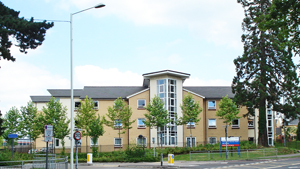
The main entrance for the Princess Royal University Hospital is signposted from Farnborough Common. New housing has been built on Barkway Drive on the southern part of the site of the old Hospital.

The main drive to the Hospital.
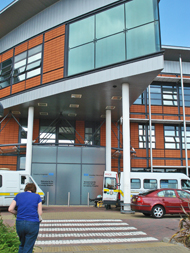
The main entrance.

The north side of the PRUH (above and below).
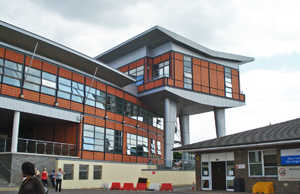
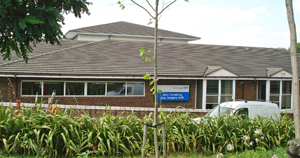
The Alan Cummings Day Surgery Unit.
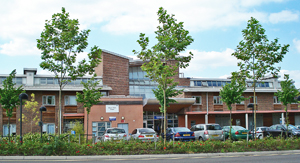
Green Parks House provides mental health care and is run by Oxleas NHS Foundation Trust.
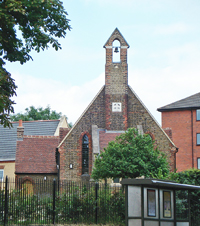
The workhouse chapel at the south of the site was converted in July 2008 and its bell restored. It is now the Primrose Centre, which finally opened in 2011 to provide support and complementary therapy for women with breast cancer.
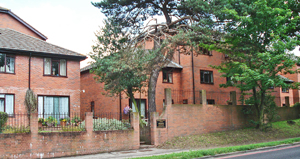
Summerlands Lodge (sheltered housing) along Farnborough Common and Wellbrook Road (above and below).
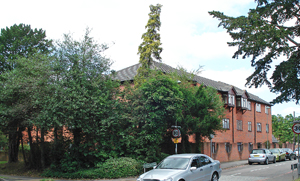
Whyler F 1978 The story of Farnbrough Hospital. Bromley Local History 3, 18-25.
http://collectionsonline.nmsi.ac.uk
http://hansard.millbanksystems.com (July 1941)
http://hansard.millbanksystems.com (June 1942)
http://hansard.millbanksystems.com (December 1944)
http://hansard.millbanksystems.com (March 1961)
http://hansard.millbanksystems.com (October 1968)
http://hansard.millbanksystems.com (July 1969)
http://hansard.millbanksystems.com (April 1976)
http://hansard.millbanksystems.com (February 1986)
http://hansard.millbanksystems.com (October 1994)
http://hidden-london.com
http://orpington-history.org
http://wikimapia.org
https://familysearch.org
www.flickr.com
www.ideal-homes.org.uk
www.sciencemuseum.org.uk
www.thisislocallondon.co.uk
Return to home page